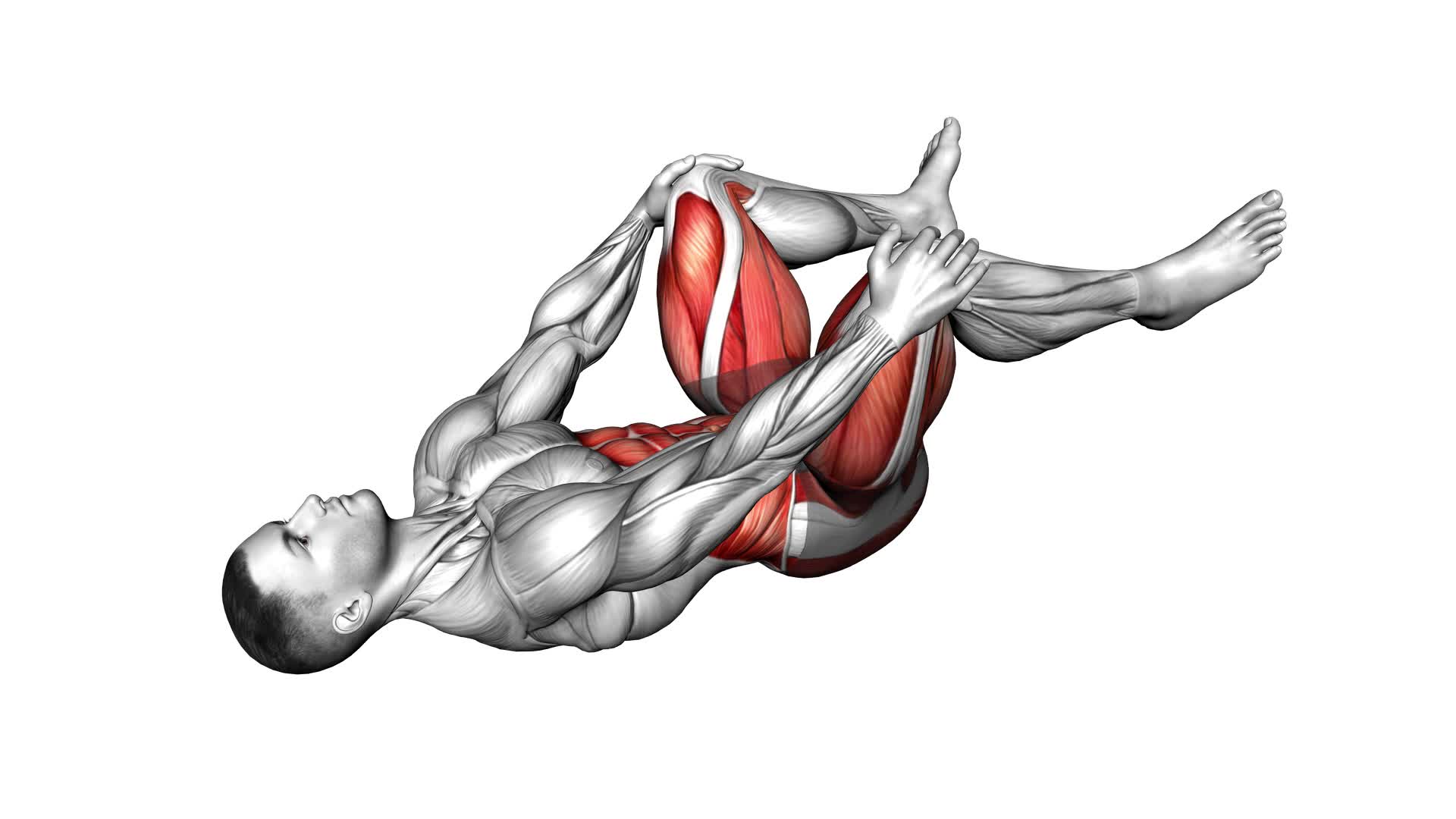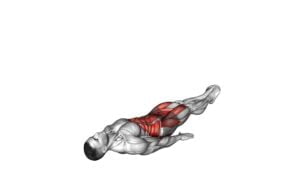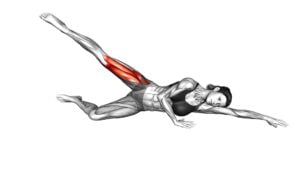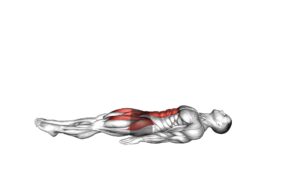Lying Hip Circle (male) – Video Exercise Guide & Tips

Looking to target your hips and strengthen your core? Check out this video exercise guide for the lying hip circle.
Watch This Exercise Video
In just a few minutes, you'll learn the proper technique, common mistakes to avoid, and tips for increasing intensity.
With variations and progressions included, you'll be able to customize your workout to fit your fitness level.
Get ready to feel the burn and take your hip workout to the next level with this informative and concise guide.
Key Takeaways
- Lying Hip Circle improves range of motion and flexibility in hips.
- It strengthens muscles in hips, glutes, and core.
- It is beneficial for athletes and individuals with wide hip movement requirements.
- Proper technique and form, as well as avoiding common mistakes, are crucial for performing the exercise effectively.
Benefits of Lying Hip Circle
To maximize your fitness routine, incorporating the lying hip circle exercise offers numerous benefits for overall strength and flexibility. This exercise, when performed correctly, can be a great addition to your hip mobility training. One of the main benefits of the lying hip circle is that it helps to improve the range of motion in your hips. By performing this exercise, you're actively engaging the muscles in your hips and working on increasing their flexibility. This can be especially beneficial for athletes or individuals who participate in activities that require a wide range of hip movement, such as dancing or martial arts.
Another benefit of the lying hip circle is that it helps to strengthen the muscles in your hips and glutes. As you move your legs in a circular motion, you're targeting these specific muscle groups, which can help to improve overall strength and stability. This can be particularly beneficial for individuals who struggle with weak hips or are recovering from hip injuries.
In addition, the lying hip circle can also help to improve your core strength. As you perform the exercise, you're engaging your core muscles to stabilize your body and maintain proper form. This can help to improve your overall balance and stability, which is important for everyday activities as well as athletic performance.
Equipment Needed for Lying Hip Circle
You will need a resistance band for the lying hip circle exercise. This equipment is essential for providing the necessary resistance to engage your hip muscles effectively.
Here are five items you can consider when choosing a resistance band:
- Level of resistance: Look for a band that offers the appropriate level of resistance for your fitness level. Bands usually come in different colors to indicate their resistance level.
- Durability: Choose a band made of high-quality materials that can withstand intense workouts and frequent use without losing elasticity.
- Comfort: Opt for a band with padded handles or a fabric covering to ensure a comfortable grip and prevent discomfort during exercises.
- Length: Consider the length of the band to ensure it provides enough tension for your desired range of motion during the lying hip circle exercise.
- Portability: Select a band that's easy to transport so you can perform the lying hip circle exercise anywhere.
While the lying hip circle exercise is an excellent way to strengthen your hips, it can be beneficial to incorporate alternative exercises for hip strengthening.
Additionally, to improve hip mobility, incorporating the best stretches for hip mobility into your routine can help increase flexibility and prevent injury.
Proper Technique for Lying Hip Circle
To perform the lying hip circle with proper technique, start by lying on your back with your knees bent and feet flat on the ground.
Engage your core and glutes as you lift your hips off the ground, forming a straight line from your shoulders to your knees.
Avoid common mistakes such as letting your knees fall inwards or arching your lower back.
Focus on maintaining proper form throughout the exercise for optimal results.
Hip Circle Form
Mastering the proper technique for the lying hip circle involves smoothly rotating your hips in a circular motion while lying down. To ensure you perform this exercise correctly, here are some key points to keep in mind:
- Engage your core muscles throughout the movement to stabilize your body.
- Maintain a steady pace and avoid rushing through the exercise.
- Focus on the quality of your movement rather than the quantity.
- Keep your hips and lower back in contact with the ground throughout the entire motion.
Experiment with different variations of the hip circle to target different muscle groups and add variety to your workouts.
Common Mistakes
To ensure proper technique for the lying hip circle, it's important to avoid these common mistakes.
One common mistake is improper breathing. Many people tend to hold their breath or breathe shallowly during this exercise, which can hinder performance and limit the effectiveness of the movement. It's important to maintain a steady and controlled breathing pattern throughout the entire exercise to ensure proper oxygen flow to the muscles.
Another common mistake is a lack of hip mobility. Some individuals may have tight hip muscles or limited range of motion, which can lead to compensatory movements or improper form. It's crucial to focus on hip mobility exercises and stretches to improve flexibility and range of motion before attempting the lying hip circle.
Common Mistakes to Avoid in Lying Hip Circle
To perform the lying hip circle correctly, it's important to maintain proper hip alignment throughout the movement.
Engage your core muscles to stabilize your pelvis and prevent excessive movement.
Avoid letting your hips drop or rotate too much, as this can lead to incorrect form and potential injury.
Proper Hip Alignment
To ensure proper hip alignment and avoid common mistakes in the lying hip circle exercise, use a firm mat or towel to support your lower back. This will help maintain a neutral spine and prevent any excessive arching or rounding.
In addition to this, here are some important tips to keep in mind:
- Engage your core muscles throughout the exercise to stabilize your pelvis and maintain control.
- Focus on initiating the movement from your hip joint, rather than relying on momentum or swinging.
- Keep your knees in line with your hips and avoid letting them fall in or out.
- Aim to create a smooth and controlled circular motion with your hips, avoiding any jerky or uncontrolled movements.
- Gradually increase the range of motion as your hip mobility and strength improve, but always listen to your body and only go as far as you can without discomfort.
Engaging Core Muscles
To avoid common mistakes in the lying hip circle exercise and effectively engage your core muscles, it's important to maintain proper hip alignment and follow these tips.
- First, focus on core stability by activating your abdominal muscles throughout the movement. This will help stabilize your spine and prevent excessive arching or rounding of the lower back.
- Additionally, engage your glutes and hip muscles to promote hip mobility and control. Avoid using momentum by moving slowly and with control, as this will maximize the activation of your core muscles.
- Lastly, make sure to breathe properly throughout the exercise, inhaling deeply before initiating the movement and exhaling as you complete each circle.
Avoiding Excessive Movement
To avoid excessive movement and maximize the effectiveness of the lying hip circle exercise, focus on maintaining proper hip alignment and engaging your core muscles throughout the movement. This will help you maintain stability and prevent unnecessary strain on your joints. Here are some tips to help you avoid excessive movement and maintain proper form:
- Keep your hips level and avoid tilting them to one side.
- Control the movement and avoid swinging your legs.
- Keep your core muscles engaged to stabilize your pelvis.
- Avoid arching your lower back excessively.
- Use controlled and deliberate movements, rather than relying on momentum.
Tips for Increasing Intensity in Lying Hip Circle
Ramp up the intensity of your lying hip circle by incorporating resistance bands for a challenging workout. Increasing resistance is a great way to push your muscles to work harder and improve strength. By attaching resistance bands around your thighs, you add extra tension, forcing your muscles to work against the resistance. This not only helps to build muscle, but it also increases the difficulty of the exercise.
In addition to increasing resistance, tempo control is another effective way to intensify your lying hip circle. By slowing down the movement and focusing on controlled, deliberate motions, you engage your muscles for a longer duration, leading to greater muscle activation and endurance. By maintaining a slow and controlled tempo, you'll feel the burn and challenge your muscles even more.
To incorporate both increasing resistance and tempo control, start by selecting a resistance band that provides enough tension to challenge you but still allows you to maintain proper form. Then, focus on maintaining a slow and controlled pace as you perform the lying hip circle exercise. Remember to engage your core and glute muscles throughout the movement for maximum effectiveness.
Variations and Progressions of Lying Hip Circle
Try incorporating different variations and progressions of the lying hip circle to challenge your muscles and keep your workout routine fresh. Here are five variations and progressions you can try:
- Resistance band hip circle: Attach a resistance band around your thighs and perform the lying hip circle. The added resistance will increase the challenge for your muscles.
- Single-leg lying hip circle: Lift one leg off the ground while performing the lying hip circle. This variation targets the glutes and hip muscles on the working leg more intensely.
- Weighted lying hip circle: Hold a dumbbell or kettlebell on your hips while performing the lying hip circle. The extra weight increases the difficulty and helps to build strength.
- Elevated lying hip circle: Place your feet on an elevated surface, such as a step or bench, while performing the exercise. This variation adds an element of instability, engaging your core muscles even more.
- Lying hip circle with pulses: After completing a full circle with your hips, pause at the top and bottom of the movement and perform small pulses. This variation increases the time under tension for your muscles, making the exercise more challenging.
Incorporating these variations and progressions will help you target different muscle groups, challenge your body in new ways, and prevent workout plateaus. Remember to listen to your body and start with lighter weights or reduced resistance if needed.
Frequently Asked Questions
How Many Sets and Reps Should I Do for the Lying Hip Circle Exercise?
For the lying hip circle exercise, it's important to find the right balance between sets and reps. The number of sets and reps can vary depending on your fitness level and goals.
Start with a moderate approach, like 3 sets of 10 reps, and gradually increase the intensity as you get stronger.
This exercise targets your hip muscles and can help improve stability and mobility.
There are also variations of the lying hip circle that you can explore to add variety to your routine.
Can I Incorporate the Lying Hip Circle Exercise Into My Lower Body Workout Routine?
Yes, you can definitely incorporate the lying hip circle exercise into your lower body workout routine.
It's a great exercise that targets your glutes, hips, and core muscles. By adding this exercise to your routine, you can improve your lower body strength and stability.
Additionally, the lying hip circle also provides benefits for your core strength, as it engages the muscles in your abdomen and lower back.
Is the Lying Hip Circle Exercise Suitable for Beginners or Is It More Advanced?
The lying hip circle exercise is a great addition to your lower body workout routine. It targets your glutes and hips, helping to strengthen and tone those muscles.
As for whether it's suitable for beginners or more advanced, modifications can be made to make it beginner-friendly. Starting with smaller movements and gradually increasing the range of motion can help beginners build strength and flexibility.
Remember to listen to your body and go at your own pace.
Can the Lying Hip Circle Exercise Help With Improving Hip Mobility?
The lying hip circle exercise is a great way to improve hip mobility. By performing this exercise, you can experience a range of benefits such as increased flexibility and strength in your hip muscles.
This exercise is suitable for all fitness levels and can be modified to suit your needs. There are variations of the lying hip circle exercise that you can incorporate into your routine to challenge yourself and further enhance your hip mobility.
Are There Any Modifications or Alternatives for the Lying Hip Circle Exercise for Individuals With Limited Range of Motion or Injuries?
If you have limited range of motion or injuries, there are modifications and alternatives available for the lying hip circle exercise. These modifications can help you still engage your hip muscles while working within your limitations.
Alternatives such as seated hip circles or standing hip abduction exercises can be effective options.
It's important to consult with a fitness professional or physical therapist to determine the best modifications or alternatives for your specific needs.
Conclusion
In conclusion, the lying hip circle is a beneficial exercise for strengthening and toning the hip muscles. By using proper technique and avoiding common mistakes, you can maximize the effectiveness of this exercise.
Additionally, there are various ways to increase the intensity and progress in the lying hip circle, allowing for continued growth and improvement.
Incorporate this exercise into your workout routine to enhance your hip strength and stability.

Author
Years ago, the spark of my life’s passion ignited in my mind the moment I stepped into the local gym for the first time. The inaugural bead of perspiration, the initial endeavor, the very first surge of endorphins, and a sense of pride that washed over me post-workout marked the beginning of my deep-seated interest in strength sports, fitness, and sports nutrition. This very curiosity blossomed rapidly into a profound fascination, propelling me to earn a Master’s degree in Physical Education from the Academy of Physical Education in Krakow, followed by a Sports Manager diploma from the Jagiellonian University. My journey of growth led me to gain more specialized qualifications, such as being a certified personal trainer with a focus on sports dietetics, a lifeguard, and an instructor for wellness and corrective gymnastics. Theoretical knowledge paired seamlessly with practical experience, reinforcing my belief that the transformation of individuals under my guidance was also a reflection of my personal growth. This belief holds true even today. Each day, I strive to push the boundaries and explore new realms. These realms gently elevate me to greater heights. The unique combination of passion for my field and the continuous quest for growth fuels my drive to break new ground.







